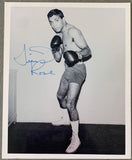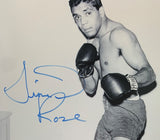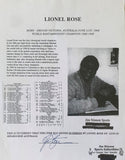ROSE, LIONEL SIGNED PHOTO (STINSON LOA)
JO Sports Inc.
Regular price $200.00
HISTORY: Lionel Edmund Rose MBE (21 June 1948 – 8 May 2011) was an Australian bantamweight boxer, the first Indigenous Australian to win a world title. After missing selection for the 1964 Olympic Games in Tokyo, Rose began his professional boxing career on 9 September 1964, outpointing Mario Magriss over eight rounds. This fight was in Warragul, but the majority of Rose's fights were held in Melbourne. Along the way he was helped by Jack and Shirley Rennie, in whose Melbourne home he stayed, training every day in their backyard gym. After five wins in a row, on 23 July 1965, Rose was rematched with Singtong Por Tor, whom he had beaten in a 12-round decision. Por Tor inflicted Rose's first defeat, beating him on points in six rounds. On 14 October of the same year, he had his first fight abroad, beating Laurie Ny by a decision in 10 rounds at Christchurch, New Zealand. Over his next nine fights, Rose had a record of eight wins and one loss, with one knockout. The lone loss in those nine fights was to Ray Perez, against whom Rose split a pair of bouts. Then, on 28 October 1966, he met Noel Kunde at Melbourne for the Australian bantamweight title. He won the title by defeating Kunde in a 15-round decision. Rose won one more belt in 1966 and eight in 1967 (including a thirteenth round knockout win against Rocky Gattellari to defend his Australian championship) before challenging Fighting Harada for the world bantamweight title on 26 February 1968 in Tokyo. Rose made history by becoming the first Aboriginal Australian to be a world champion boxer when he defeated Harada in a 15-round decision.[5]. This win made Rose an instant national hero in Australia and an icon among Aboriginal Australians. A public reception at Melbourne Town Hall was witnessed by a crowd of more than 100,000. On 2 July of that year, he returned to Tokyo to retain his title with a 15 round decision win over Takao Sakurai. Then, on 6 December, he met Chucho Castillo at the Inglewood Forum in Inglewood, California. Rose beat Castillo by decision, but the points verdict in favour of him infuriated many in the pro-Castillo crowd and a riot began: 14 fans and fight referee Dick Young were hospitalised for injuries received. On 8 March 1969, Rose retained the title with a 15-round decision over Alan Rudkin, but five months later he returned to Inglewood, where he faced Rubén Olivares on 22 August. Rose lost the world bantamweight title to Olivares via a fifth-round knockout. Rose continued boxing after his defeat against Olivares, but, after defeats against practically unknown fighters, many believed he was done as a prime fighter. However, he was far from finished: he upset future world lightweight champion Itshimatsu Suzuki on 10 October 1970 in a 10-round decision, and once again, he positioned himself as a world title challenger, albeit in the lightweight division, 17 pounds over the division where he crowned himself world champion. Despite having lost to Jeff White for the Australian lightweight title, Rose got another world title try when he faced WBC world junior lightweight champion Yoshiaki Numata, on 30 May 1971 at Hiroshima. Numata beat Rose by a fifteen round decision, and Rose announced his retirement soon after. In 1975, he came back, but after losing four of his next six bouts, including one against Rafael Limón, Rose decided to retire for good. Rose compiled a record of 42 wins and 11 losses as a professional boxer, with 12 wins by knockout. In 2007, Rose suffered a stroke that left him with speech and movement difficulties. Rose died on 8 May 2011 after an illness which lasted for several months. Offered here is a signed photo of Lionel Rose in full fight pose. LOA from Jim Stinson who conducted the signing session with Rose on March 3, 1993.
FULL DESCRIPTION: This is a black and white photograph of Lionel Rose in full fight pose. Boldly signed in blue sharpie . "Lionel Rose." 8" x 10." No creases or tears. Clean front and back. Bold, clear image. Signed on March 3, 1993 in Melbourne, Australia. Comes with a letter of authenticity from Jim Stinson who personally obtained the autograph.
Size: 8" x 10"
Condition: Mint






